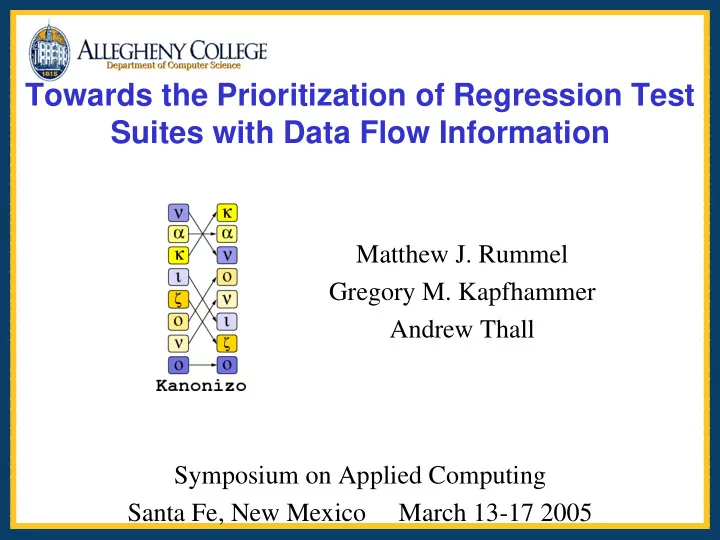

Towards the Prioritization of Regression Test Suites with Data Flow Information Matthew J. Rummel Gregory M. Kapfhammer Andrew Thall Symposium on Applied Computing Santa Fe, New Mexico March 13-17 2005
Definitions � Test Case – An individual unit test � Test Suite – A tuple of test cases � Regression Testing – Testing that occurs after the completion of development or maintenance activities when a test suite comprised of all accumulated unit tests is executed � Test Prioritization – The process of arranging test cases in a given test suite to facilitate the detection of defects earlier in the execution of the test suite
Motivation � Regression testing may account for as much as one-half the cost of software maintenance � Prioritization is often more feasible than test selection � Tests that fulfill the all-DUs test adequacy criteria are more likely to reveal defects than those that satisfy control flow based criteria
Dataflow � Model each method in a program as a control flow graph � Control flow flow family of test criteria (ex: all-nodes , all edges , all- paths ) � Data flow criteria evolved from control flow (ex: all-DUs , all-P-Uses , all-C-Uses ) � Focus on intraprocedural def-use associations
Metrics � APFD – The rate of fault detection per percentage of test suite execution ∑ = g ( , ) reveal i T 1 = − + 1 i ( , ) 1 APFD T P 2 rg r � PTR – Percentage of a given test suite that must be executed for all faults to be detected r g = ( , ) PTR T P r
Metrics Example σ 1 = 〈 T 1 , T 2 , T 3 , T 4 , T 5 〉 σ 2 = 〈 T 3 , T 4 , T 1 , T 2 , T 5 〉 � APFD(T 1 , P) = 1 - .4 + .1 =.7 4 � PTR(T 1 , P) = 5 � APFD(T 2 , P) = 1 - .2 + .1 =.9 2 � PTR(T 2 , P) = 5
Experiment Design InstrumentandEnumerate � Calculate the set of test requirements for program P � Introduce test coverage monitoring instrumentation � Execute test suites and report APFD and PTR calculations
Cumulative Adequacy of a Test Case � When a test case has covered both a def and corresponding use statement, the coverage of that association is stored � Test case adequacy – The ratio between the number of covered test requirements and the total number of test requirements for all of the methods under test ∑ h | ( ) | R m c k = = 1 k ( ) adeq T ∑ f h | ( ) | R m k = 1 k
Cumulative Adequacy Example � Model each method in a program as a control flow graph � T f enters method m and executes the true branch of node 3 7 = = ( ) 43 . 75 % adeq T � f 16
Experimentation Statistics � Experiments conducted on a GNU/Linux workstation with dual 1GHz Pentium III Xeon processors, 512 MB of main memory Case study applications: � Bank – 1 class, 53 def-use associations, 5 methods, 7 test cases, 4 seeded errors � Identifier – 3 classes, 81 def-use associations, 13 methods, 11 test cases, 2 sets of 3 seeded errors � Money – 3 classes, 302 def-use associations, 33 methods, 21 test cases, 3 sets of 3 seeded errors
Bank APFD and PTR Measurements � Prioritized suite has best PTR value � Prioritized suite has the best APFD value, slightly better than Random1
Identifier APFD and PTR Measurements � Prioritized suite has the worst PTR value � Prioritized suite has the worst APFD value
Money APFD and PTR Measurements � Prioritized suite has best APFD for 3 errors, worst for 6 errors, medium for 9 errors � Prioritized suite has medium APFD for 3 errors, slightly worse than Random1, worst for 6 errors, medium for 9 errors
Time and Memory Requirements Time and Memory for InsturmentandEnumerate Algorithm � Test case monitoring did not cause significant increases in the time required to execute test cases
Conclusions � Test suites can be prioritized according to all-DUs with minimal time and space overhead � Preliminary results indicate that data flow-based prioritizations are not always more effective than random prioritizations � Successfully created a low-overhead framework for performing test prioritization which can be used in future studies
Future Work � Incorporation of control flow-based and mutation-based adequacy into Kanonizo � The comparison of our prioritization approach to other prioritization schemes beyond random � The calculation of APFD and PTR for all permutations of an application’s test suite � Experimentation with additional case studies that have larger program segments and test suites � The investigation of prioritization techniques for test suites that must be executed within a specified time constraint
Related Work � Sebastian Elbaum et al. Prioritizing test cases for regression testing. Proceedings of the International Symposium on Software Testing and Analysis . ACM Press, August 2000. � Phyllis G. Frankl et al. An applicable family of data flow testing criteria. IEEE Transactions on Software Engineering , October 1988. � G. Rothermel et al. A framework for evaluating regression test selection techniques. Proceedings of the 16 th International Conference on Software Engineering, IEEE Computer Society Press , May 1994.
Resources � Kanonizo Research Group: http://cs.allegheny.edu/~gkapfham/research/kanonizo. � Gregory M. Kapfhammer The Computer Science Handbook Chapter “Software Testing”. CRC Press, June 2004. � Matthew Rummel, Greg Kapfhammer, and Andrew Thall Towards the Prioritzation of Regression Test Suites with Data Flow Information. Proceedings of the ACM SIGAPP Symposium on Applied Computing , Santa Fe, New Mexico, March 2005.
Recommend
More recommend